I wouldn’t recommend attempting to remove actinic keratosis at home. In any case here you can find some recommended treatments and prevention tips. Actinic keratosis is a pre-cancerous skin lesion and needs to be treated carefully.
Actinic keratosis affects millions of people who have spent years in the sun, creating rough and scaly patches on exposed skin areas. This common skin condition develops from long-term UV damage and requires careful attention since it can potentially progress to skin cancer if left untreated.
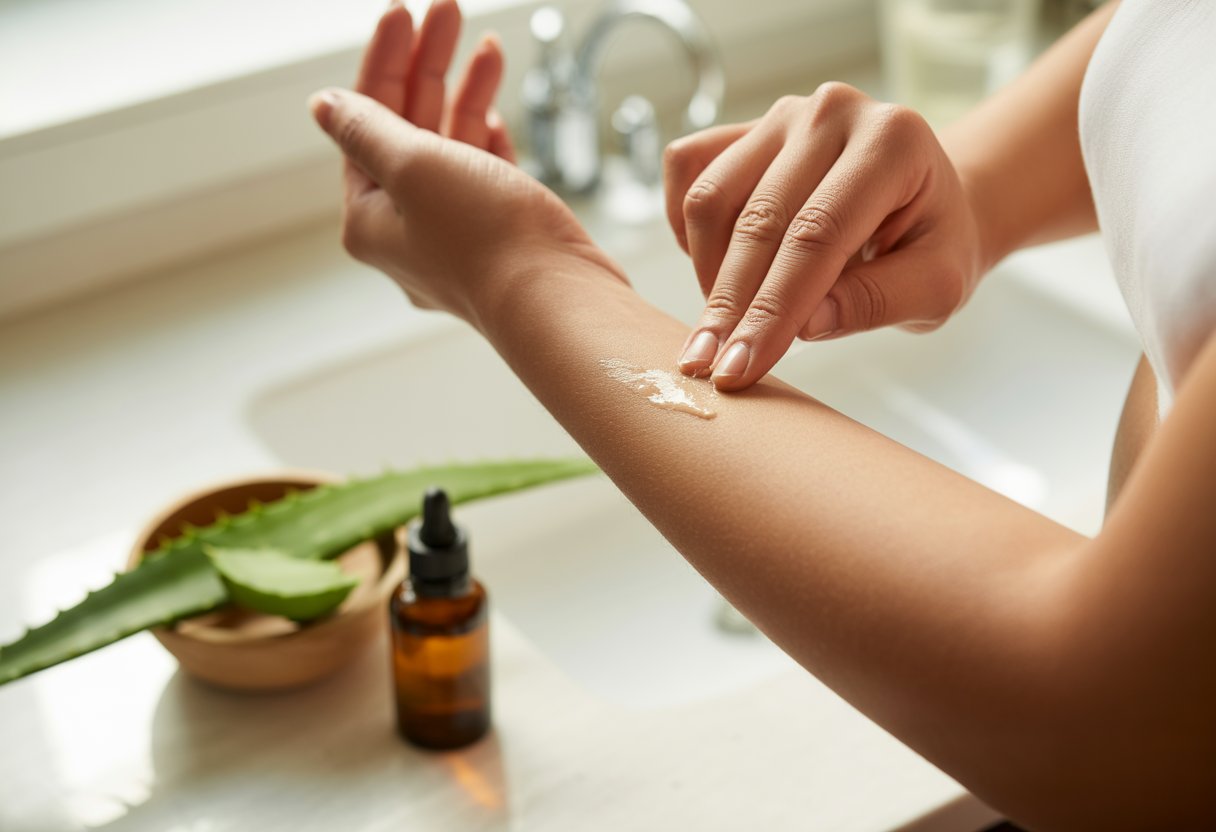
People can treat mild actinic keratosis at home using dermatologist-prescribed medications, natural remedies like green tea extract and aloe vera, and protective lifestyle changes. At-home treatment for actinic keratosis works best when supervised by a medical professional who can monitor progress and ensure safety.
Understanding the right approach to home treatment can help people manage this skin condition effectively while knowing when professional intervention becomes necessary. The key lies in combining proven remedies with consistent sun protection and regular skin monitoring.
Key Takeaways
- Actinic keratosis can be treated at home with dermatologist-approved medications and natural remedies when properly supervised
- Regular sun protection and lifestyle changes are essential for preventing new patches and managing existing ones
- Professional medical evaluation remains important to monitor progress and rule out more serious skin conditions
Understanding Actinic Keratosis and Its Risks
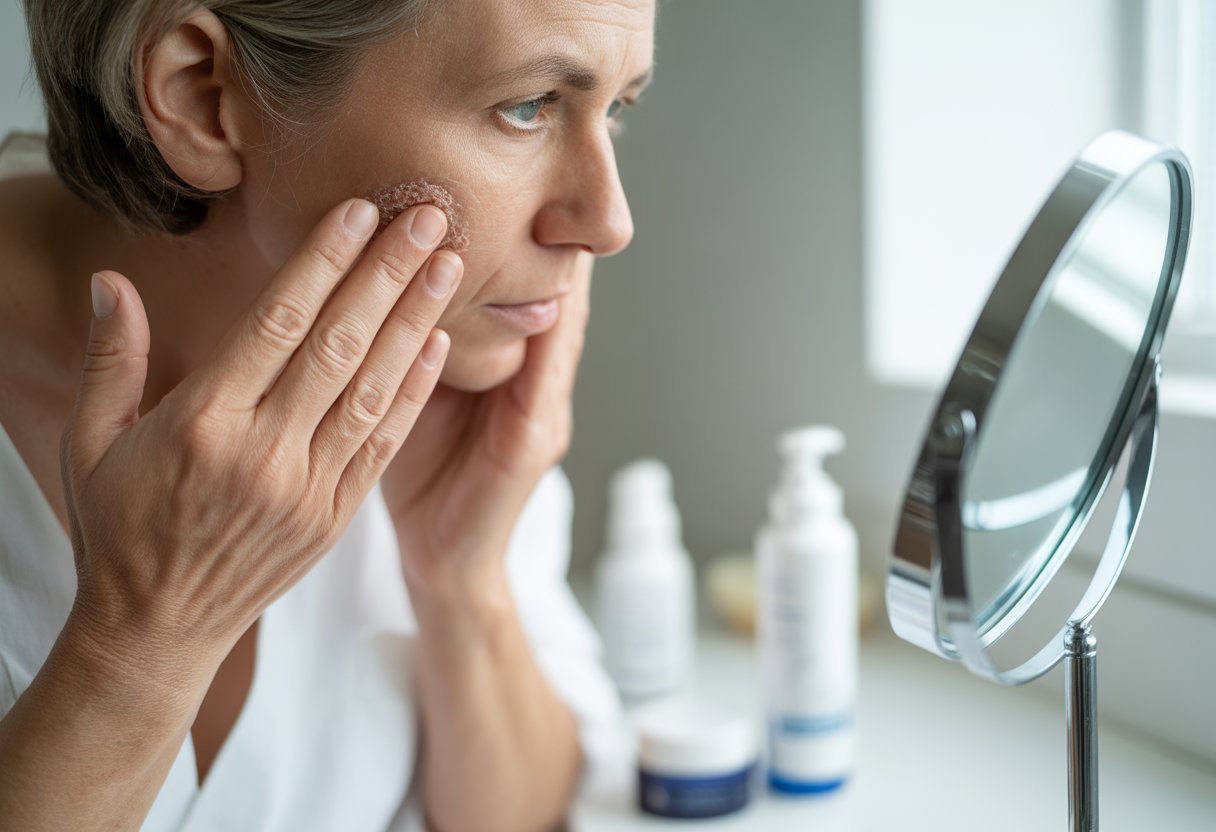
Actinic keratosis develops from years of sun damage and creates rough, scaly patches on the skin. These precancerous skin lesions pose a real risk of turning into skin cancer if left untreated.
What Is Actinic Keratosis?
Actinic keratosis (AK) is a common skin condition caused by long-term sun exposure that creates abnormal skin cells on the outer layer of skin. These lesions appear as rough, scaly, or crusty patches on sun-exposed areas.
The patches typically feel sandpaper-like to the touch. They range in color from pink to red to brown.
Common locations include:
- Face and ears
- Scalp (especially in bald areas)
- Neck and shoulders
- Arms and hands
- Chest and back
AK lesions usually measure between 2-6 millimeters across. Some people develop just one or two spots, while others may have dozens.
The patches may itch or burn slightly. They often become more noticeable in bright sunlight.
How Sun Exposure Contributes to AK
Years of UV radiation damage the DNA in skin cells and trigger the formation of actinic keratosis. The sun’s harmful rays penetrate the skin and create changes in the cells over time.
Risk factors include:
- Fair skin that burns easily
- Light-colored eyes and hair
- History of frequent sunburns
- Living in sunny climates
- Working outdoors regularly
- Using tanning beds
The damage builds up slowly over decades. Most people with AK are over age 50, though younger people can develop it too.
People with weakened immune systems face higher risks. Those who take certain medications may also be more likely to develop these lesions.
Potential Progression to Skin Cancer
Actinic keratosis can sometimes turn into skin cancer called squamous cell carcinoma. About 5-10% of untreated AK lesions become cancerous over time.
Doctors cannot predict which lesions will become dangerous. This uncertainty is why they’re usually removed as a precaution.
Warning signs of progression include:
- Rapid growth or size changes
- Bleeding or ulceration
- Increased thickness or elevation
- New pain or tenderness
Some actinic keratoses disappear on their own but may return with more sun exposure. Early treatment reduces the risk of cancer development significantly.
People with multiple AK lesions have higher chances of developing skin cancer somewhere on their body. Regular skin checks become essential for monitoring changes.
Recognizing Symptoms and When to See a Dermatologist
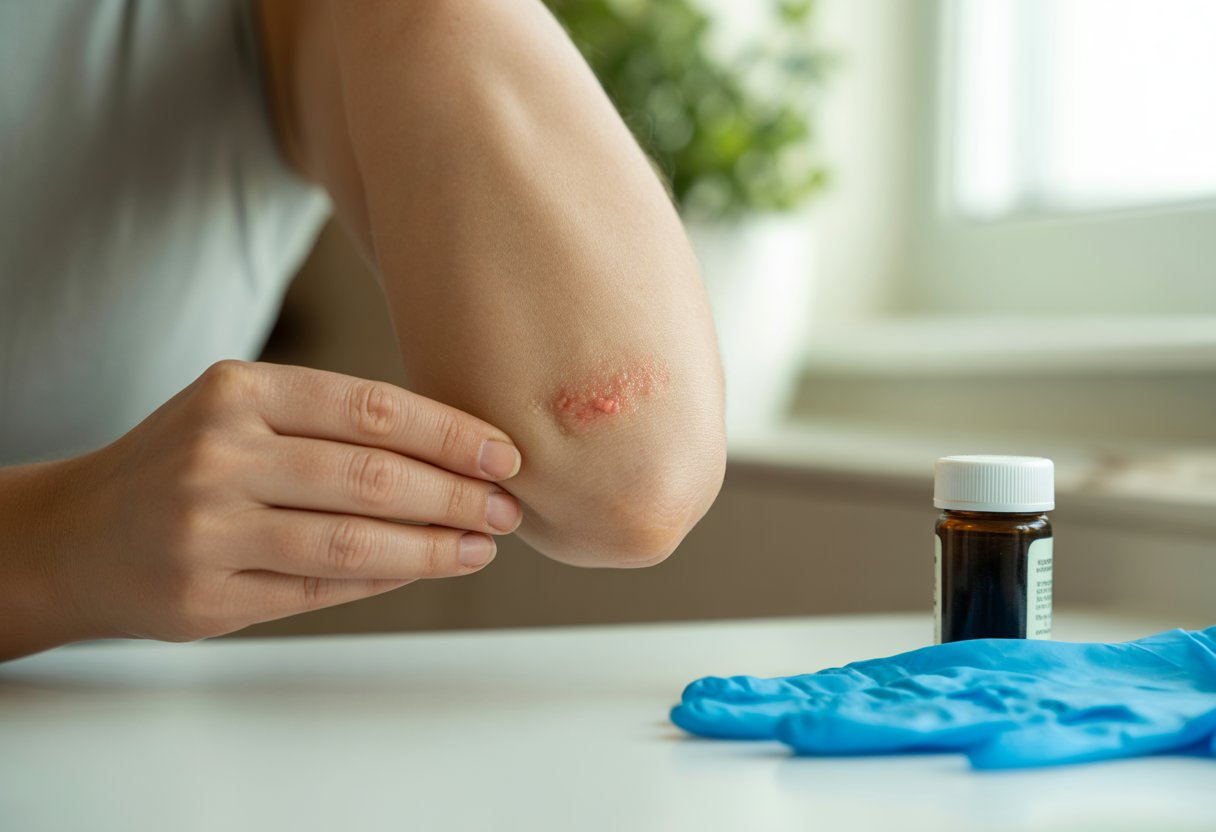
Actinic keratosis appears as rough, scaly patches on sun-exposed areas of the skin. Knowing when these skin lesions require professional medical attention helps prevent potential complications.
Identifying Scaly Patches and Other Signs
Actinic keratosis lesions appear on parts of the body regularly exposed to sun. The most common locations include the face, ears, scalp, neck, and hands.
Key Physical Characteristics:
- Rough, scaly texture that feels like sandpaper
- Small patches ranging from 2mm to 2cm in size
- Colors varying from pink to red to brown
- Raised or flat appearance on the skin surface
The skin condition often causes itching or burning sensations. Some people experience tenderness when touching the affected area.
These scaly patches may feel dry and crusty. The texture remains consistently rough even after applying moisturizer.
Common Locations on the Face:
- Forehead and temples
- Bridge of the nose
- Cheekbones
- Lower lip
- Ear tops and edges
The patches may appear alone or in clusters. Multiple lesions often develop in people with extensive sun damage.
Knowing When to Consult a Dermatologist
Multiple actinic keratosis or those that cause symptoms usually require removal. Professional evaluation becomes necessary when certain warning signs appear.
Immediate Medical Attention Required:
- Bleeding from the lesion
- Rapid growth or size changes
- Development of thick, horn-like growths
- Ulceration or open sores
- Severe pain or tenderness
A dermatologist should evaluate any suspected actinic keratosis to prevent potential cancer development. Professional diagnosis ensures proper treatment selection.
Schedule an appointment if home treatments fail after 2-3 months. Persistent or worsening skin lesions require medical intervention.
When Professional Treatment Is Recommended:
- More than 5 patches on the body
- Patches larger than 1 centimeter
- Lesions that interfere with daily activities
- History of skin cancer in the family
- Immunocompromised health status
Regular dermatology checkups help monitor existing patches and detect new ones early.
Home Remedies for Actinic Keratosis
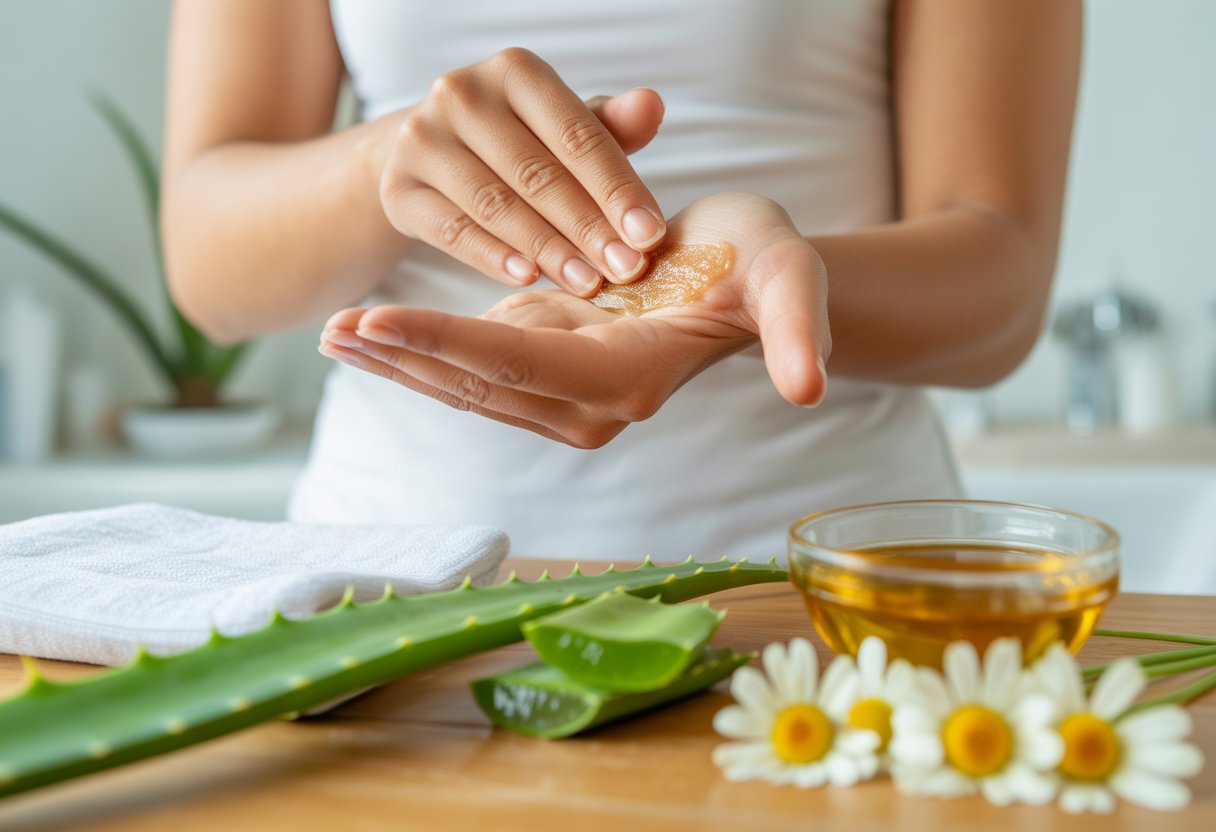
Natural remedies like green tea extract, apple cider vinegar, and aloe vera may help manage actinic keratosis symptoms through their antioxidants and anti-inflammatory properties. These treatments work best when combined with proper sun protection and medical guidance.
Green Tea Extract Applications
Green tea extract contains powerful antioxidants called polyphenols that may help damaged skin cells. These compounds can reduce inflammation and support skin health.
People can apply green tea extract directly to affected areas twice daily. The extract should be diluted with water to prevent skin irritation.
Application Methods:
- Mix 1 part green tea extract with 2 parts water
- Apply with a clean cotton pad
- Leave on skin for 15-20 minutes
- Rinse with cool water
Some individuals brew strong green tea and let it cool completely. They then soak a cloth in the tea and place it on the affected skin for 10 minutes.
The antioxidants in green tea may help protect skin from further damage. Regular use over several weeks may show gradual improvement in skin texture.
Apple Cider Vinegar Methods
Apple cider vinegar contains acids that may help remove damaged skin cells. The vinegar should always be diluted before applying to prevent burns or irritation.
A common method involves mixing one part apple cider vinegar with three parts water. Users apply this mixture to the affected area using a cotton swab.
Safety Guidelines:
- Always dilute the vinegar
- Test on a small skin area first
- Apply for only 5-10 minutes initially
- Stop use if severe irritation occurs
Some people prefer soaking a small bandage in diluted apple cider vinegar. They place this on the affected spot for short periods.
Natural remedies for actinic keratosis suggest starting with very diluted solutions. The concentration can be gradually increased if the skin tolerates it well.
Aloe Vera for Soothing and Healing
Aloe vera offers anti-inflammatory benefits that can calm irritated skin. The gel inside aloe vera leaves contains compounds that may promote healing.
Fresh aloe vera gel works best for treating actinic keratosis. People can cut open an aloe leaf and apply the clear gel directly to affected areas.
Application Tips:
- Use fresh gel from the plant
- Apply 2-3 times daily
- Allow gel to absorb completely
- No need to rinse off
Store-bought aloe vera gel can also be effective. Users should choose products with at least 90% pure aloe vera content.
The cooling effect of aloe vera provides immediate relief from itching or burning. Self-treatment options for actinic keratosis often include aloe vera as a gentle, daily treatment.
Regular aloe vera use may help soften rough, scaly patches. The anti-inflammatory properties support overall skin health during the healing process.
Additional Natural Treatments and Supportive Oils
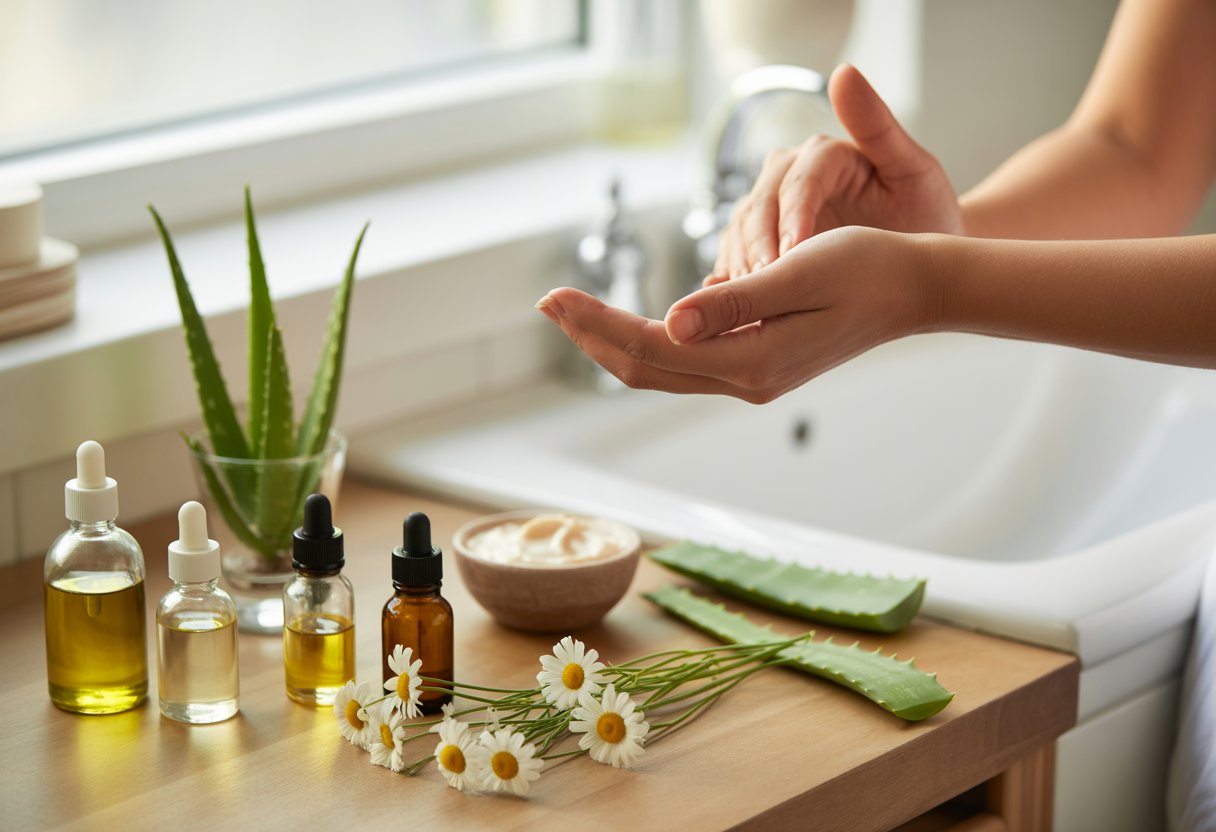
Coconut oil provides protective benefits through its natural compounds, while essential oils offer therapeutic properties that may support skin healing. Both treatments work as gentle alternatives for managing actinic keratosis symptoms.
Coconut Oil for Skin Protection
Organic virgin coconut oil applications can help address actinic keratosis spots over time. Regular use on affected areas of the face, forehead, nose, scalp, and neck may gradually improve skin appearance.
Coconut oil contains lauric acid and caprylic acid. These compounds have anti-inflammatory properties that can soothe irritated skin.
The oil also provides:
- Natural moisturizing benefits
- Protection from environmental damage
- Gentle treatment for sensitive areas
People should apply the oil twice daily to clean, dry skin. Consistent use over several months shows better results than occasional application.
The antioxidants in coconut oil help protect skin cells from further damage. This protection supports overall skin health while the affected areas heal.
Essential Oils and Their Properties
Essential oils support skin healing through their natural therapeutic compounds. These oils provide a gentle approach to managing actinic keratosis symptoms.
Tea tree oil contains terpinen-4-ol, which has anti-inflammatory effects. Users should dilute it with a carrier oil before applying to prevent skin irritation.
Frankincense oil offers these benefits:
- Promotes cell regeneration
- Reduces inflammation
- Supports healthy skin renewal
Lavender oil provides soothing properties and may help reduce redness. It also has mild antiseptic qualities that keep treated areas clean.
People should always dilute essential oils with coconut oil or another carrier oil. A ratio of 2-3 drops of essential oil per tablespoon of carrier oil works well.
Patch testing on a small skin area helps identify any allergic reactions before full application.
Lifestyle Adjustments for Prevention and Maintenance
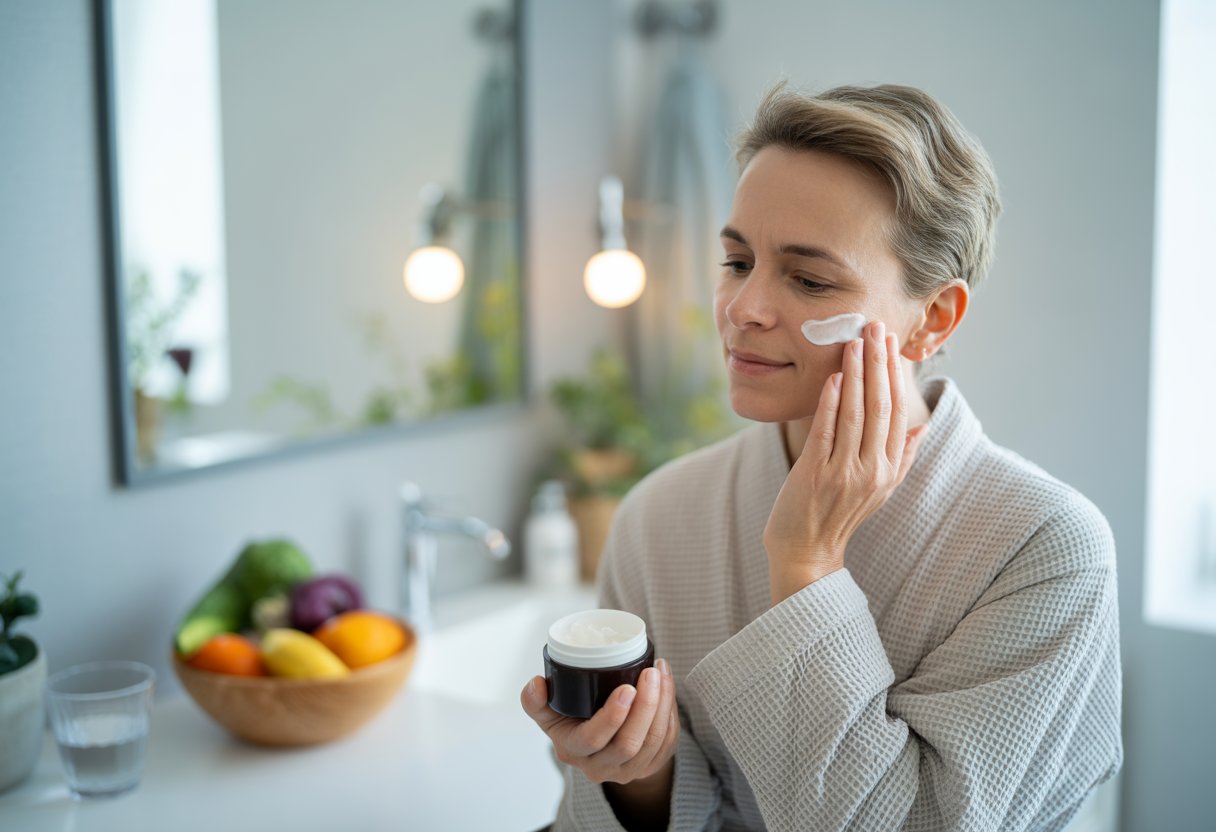
Making smart daily choices can stop new actinic keratoses from forming and help existing spots from getting worse. The right sun protection habits, eating foods that support skin health, and checking your skin regularly are the three most important steps.
Effective Sun Protection Strategies
Daily sunscreen use forms the foundation of actinic keratosis prevention. People should apply broad-spectrum SPF 30 or higher sunscreen to all exposed skin 15-20 minutes before going outside.
Key Sun Protection Guidelines:
- Reapply sunscreen every 2 hours
- Use extra sunscreen after swimming or sweating
- Apply 1 ounce (2 tablespoons) for full body coverage
- Choose water-resistant formulas for outdoor activities
Protective clothing works better than sunscreen alone. Wide-brimmed hats shield the face, ears, and neck from harmful UV rays. Long-sleeved shirts and pants provide extra coverage during peak sun hours.
Timing outdoor activities reduces sun exposure significantly. The sun’s rays are strongest between 10 AM and 4 PM. People can schedule walks, gardening, and sports for early morning or evening hours instead.
Seeking shade whenever possible cuts UV exposure by up to 75%. Trees, umbrellas, and covered patios offer natural protection during outdoor events and activities.
Healthy Dietary Choices for Skin Health
Antioxidants from food help protect skin cells from sun damage and may slow the development of actinic keratoses. These nutrients fight harmful free radicals that contribute to skin aging and cancer.
Top Antioxidant-Rich Foods:
- Berries (blueberries, strawberries, blackberries)
- Leafy greens (spinach, kale, arugula)
- Colorful vegetables (bell peppers, tomatoes, carrots)
- Nuts and seeds (almonds, sunflower seeds, walnuts)
Vitamin C supports collagen production and skin repair. Citrus fruits, bell peppers, and broccoli provide high amounts of this essential nutrient.
Omega-3 fatty acids reduce inflammation in skin cells. Fish like salmon, sardines, and mackerel contain these healthy fats. Plant sources include flaxseeds, chia seeds, and walnuts.
Green tea contains powerful compounds called catechins that may protect against UV damage. Drinking 2-3 cups daily provides skin-protective benefits.
Regular Skin Self-Examinations
Monthly skin checks help people spot new actinic keratoses or changes in existing spots early. Early detection makes treatment easier and more effective.
People should examine their entire body in good lighting using a full-length mirror. A hand mirror helps check hard-to-see areas like the back, scalp, and behind ears.
What to Look For:
- Rough, scaly patches
- Red or brown spots
- Areas that feel different from surrounding skin
- Spots that bleed, itch, or don’t heal
Taking photos of suspicious spots helps track changes over time. People can compare monthly photos to see if spots are growing, changing color, or developing new features.
Anyone who finds new or changing skin spots should see a dermatologist promptly. Medical supervision ensures proper diagnosis and appropriate treatment for suspicious lesions.
Limitations and Risks of At-Home Treatments
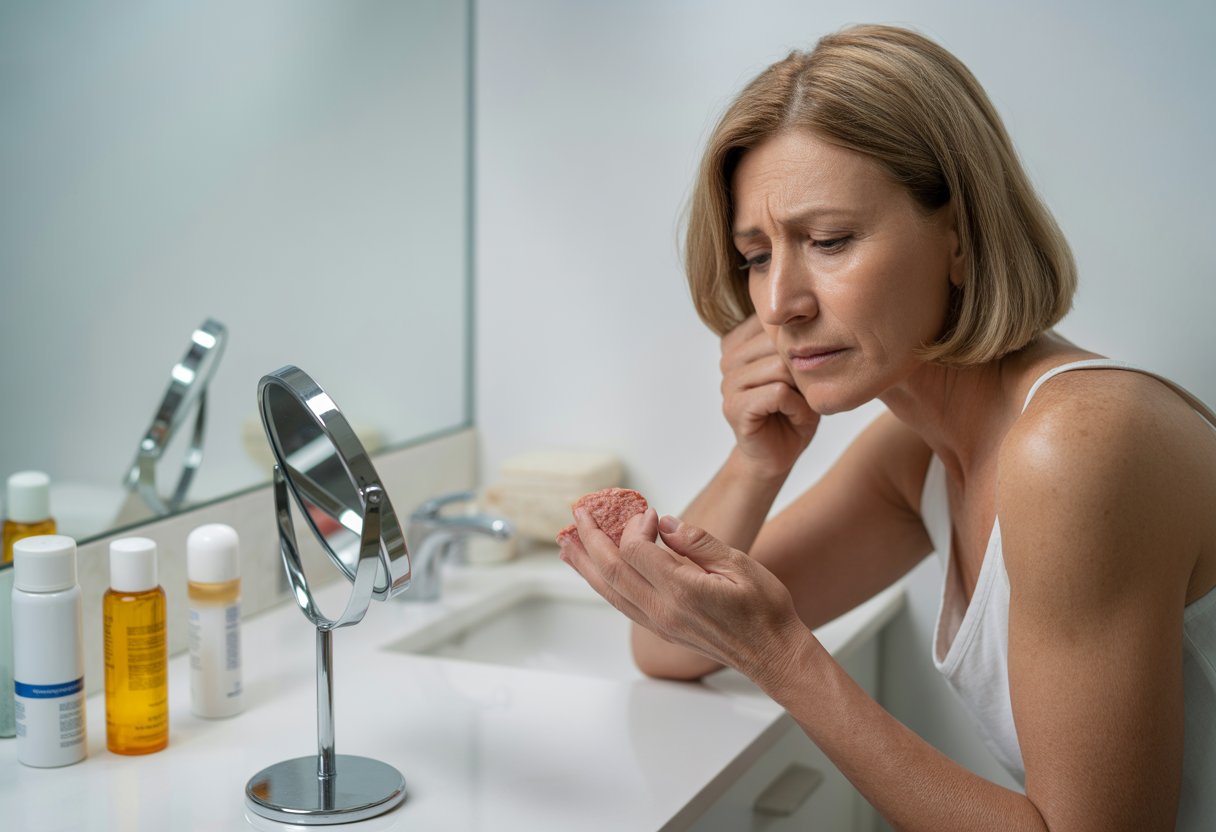
Home treatments for actinic keratosis carry significant risks that can worsen the condition or delay proper care. Some natural remedies can damage healthy skin, while avoiding professional treatment allows these lesions to potentially develop into skin cancer.
When Home Remedies May Be Harmful
Many natural remedies lack scientific evidence and can cause serious skin damage. Acidic substances like apple cider vinegar or lemon juice can burn healthy skin around the lesion. These treatments may create open wounds that become infected.
Common side effects include redness, inflammation, burning sensation, and temporary skin irritation. Severe reactions can leave permanent scars or hyperpigmentation.
Home treatments cannot target specific skin lesions like professional methods. Cryotherapy and laser therapy require precise application to avoid damaging surrounding tissue. DIY approaches lack this precision.
High-risk home remedies include:
- Essential oils applied directly to skin
- Harsh scrubbing or picking at lesions
- Unregulated topical products
- Heat treatments or caustic substances
People with sensitive skin face higher risks of adverse reactions from untested remedies.
Dangers of Delaying Professional Treatment
Actinic keratoses can develop into squamous cell carcinoma if left untreated. A small percentage of AKs develop into a form of skin cancer, making early professional intervention crucial.
Actinic keratoses will not go away by itself, so patients need to work with a dermatologist to find effective treatment. Delaying care allows more lesions to develop and existing ones to progress.
A dermatologist can distinguish between different types of skin lesions. Some growths that appear similar to actinic keratosis may already be cancerous. Home treatments cannot provide this diagnostic accuracy.
Risks of delayed treatment:
- Progression to skin cancer
- Spread to surrounding areas
- Need for more aggressive treatments later
- Difficulty distinguishing benign from malignant lesions
Professional treatments like cryotherapy show higher success rates than home remedies for complete lesion removal.
Frequently Asked Questions
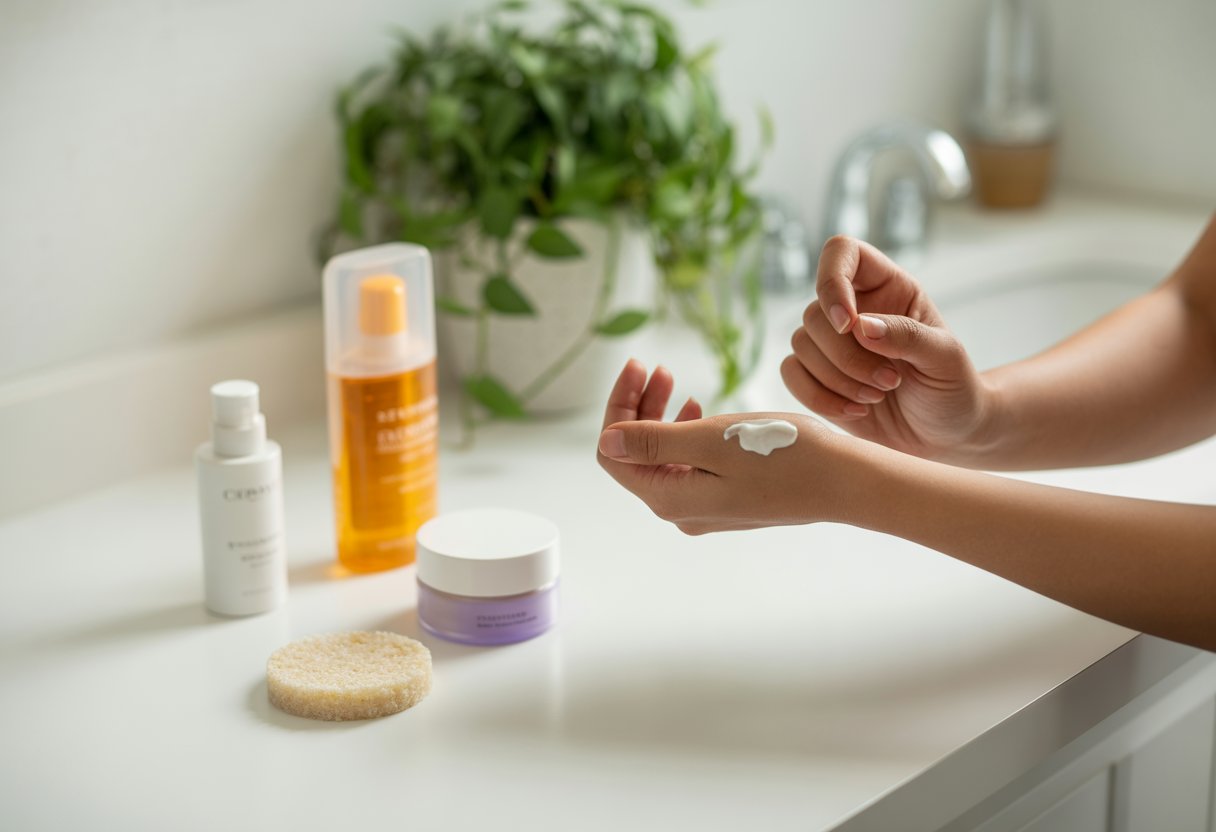
People often have specific questions about treating actinic keratosis at home. These common concerns focus on treatment options, natural remedies, healing times, new therapies, risks of avoiding treatment, and what changes to expect during recovery.
What is the most effective over-the-counter cream for treating actinic keratosis?
No over-the-counter creams are proven to effectively treat actinic keratosis. The condition requires prescription medications that a doctor must prescribe after proper diagnosis.
Prescription treatments from dermatologists are the only proven effective topical options. These medications include 5-fluorouracil, imiquimod, and diclofenac gel.
Patients should avoid relying on over-the-counter products for this condition. Only prescription treatments have clinical evidence showing they can remove actinic keratosis lesions safely.
Can actinic keratosis be successfully treated with natural remedies?
Natural remedies for actinic keratosis exist but lack strong scientific evidence. Common natural approaches include green tea extract, aloe vera, and apple cider vinegar.
Natural treatments may help soothe symptoms but cannot replace medical treatment. These remedies might reduce irritation but do not eliminate the abnormal skin cells.
Doctors recommend using natural remedies only as supportive care alongside prescription treatments. Patients should never rely solely on natural remedies for this potentially serious skin condition.
How long does it typically take to see improvement in actinic keratosis lesions after beginning treatment?
Treatment duration varies depending on the medication and severity of lesions. Most prescription treatments require 2 to 16 weeks of consistent application.
Initial improvement often appears within 2 to 4 weeks of starting treatment. Complete healing may take several months after finishing the medication course.
Patients may notice redness, peeling, and irritation during treatment. These reactions are normal and indicate the medication is working to remove abnormal skin cells.
Are there any new treatments for actinic keratosis that have shown promising results?
Photodynamic therapy combines light treatment with topical medications. This approach shows good results for patients with multiple lesions in large areas.
Laser treatments and chemical peels offer newer options for some patients. These procedures require professional administration and may work well for specific types of lesions.
Combination therapies using multiple treatments together show promise. Research continues to explore new medications and treatment approaches for better outcomes.
What are the potential risks of leaving actinic keratosis untreated?
Actinic keratosis can develop into squamous cell skin cancer if left untreated. This type of skin cancer requires more aggressive treatment and can spread to other parts of the body.
The risk of cancer development varies but affects approximately 5 to 10 percent of untreated lesions. Early treatment prevents this progression and eliminates the abnormal cells.
Multiple untreated lesions increase the overall cancer risk. Patients with many actinic keratoses face higher chances of developing skin cancer over time.
What should I expect in terms of changes to the appearance of actinic keratosis after treatment?
Treatment typically causes redness, swelling, and peeling in the treated area. These reactions are normal and show the medication is removing abnormal skin cells.
The lesion may appear worse before it improves. Patients often see increased roughness and scaling during the first few weeks of treatment.
After successful treatment, the skin usually returns to normal appearance. Some areas may remain slightly lighter or darker than surrounding skin permanently.
Complete healing reveals smooth, healthy skin where the lesion existed. The treated area should no longer feel rough or scaly to the touch.